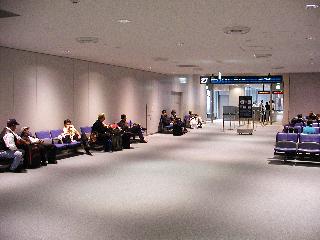
Waiting in Tokyo
The trip to Beijing won't be empty, and I'm not the only westerner going there. Despite the SARS scare, not everybody is staying away.425=Marco Polo Hotel, Beijing=A yellow sun rose in a saffron sky this morning. Looking out over from the sixth floor of the Marco Polo Hotel, I get my first glimpse of Beijing.
The city is preparing for the upcoming Olympics with great zeal, and outside my window is just one bit of evidence: an entire block reduced to an empty lot, and a skyline filled with cranes.
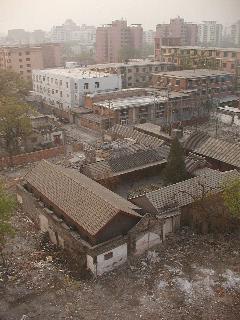
p4244318.jpg
Actually, not the entire block. One building remains standing, surrounded by the remains of buildings that once stood beside it.
Elsewhere throughout the city, some older buildings are painted with the sign of death, meaning that they're scheduled for imminent demolition. But the tear-down is not universal; there are districts in which many of the older buildings are being kept.
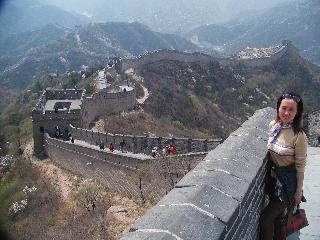
Steep Climb
We started the ascent at a point that isn't visible (below the ridge at right) and we're almost, but not quite, to the highest peak. Oh, and meet Jingjing, the local guide for Beijing. She's a veritable fountain of information about the city and surrounding area, and an astute hostess (especially considering the SARS situation in Beijing!)
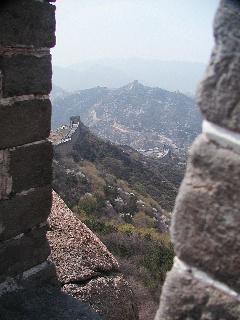
Over the Rampart
Down there is -- or used to be -- foreign land. Standing here on the BaDaLing portion of the Great Wall, just north of Beijing, sentries used to watch the northern frontier. Now, of course, both sides are deep within China's boundaries.
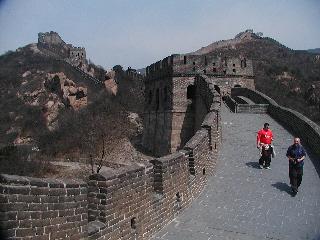
Empty Walls
Looking eastward, we see several fortified towers; these used to serve as barracks for soldiers stationed on the wall, as well as communication centers. Messages used to be passed along the line toward Beijing via smoke, pennant, or fire signals. While soldiers still stand on the wall, they're far more welcoming of the invading hoards now (although currently there just aren't that many of us foreigners...)
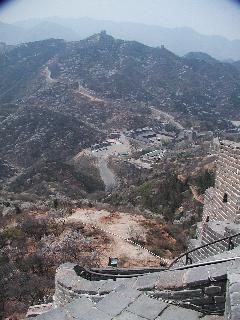
On the "Chinese" Side
Looking westward, the left side of this picture is what used to be old China; the right, the Mongolian frontier. Late April finds the countryside abloom with blossoms, and concerns over SARS causes the walls to be quite devoid of tourists.
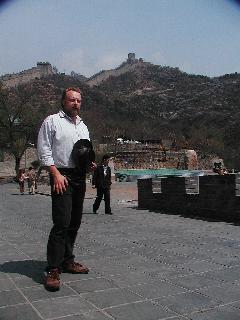
p4244339.jpg
Jingjing, the tour guide insisted that I spend some time in front of the camera, instead of just behind it. So I guess this ends up being proof that I was actually there ;-) I actually wanted a lawn gnome to take my place, but there weren't any to be found.
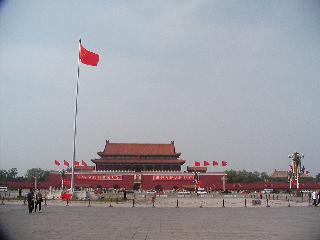
South Gate of Forbidden City
The Tiananmen Square, known to most Americans only for the events of the late eighties, is not unlike the mall in Washington DC: the great public space symbolizing the convergence of people and government. Once the "front yard" to the Forbidden City, it used to be enclosed and accessible only to military and civil officials. Those buildings and walls are now gone, and the plaza is the largest city center.

Maoist Monuments
In the foreground, just behind the row of banners, is a monument commemorating the heroes of China, with praises in the Chairman's own hand depicted along its face. Behind it is the mausoleum in which the body of the former leader rests in a crystal coffin.
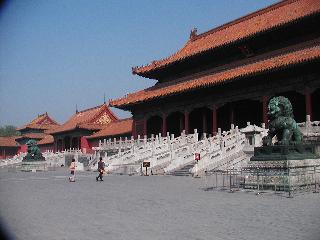
Lions Guard the Gate
A male and female lion guard these gates. The male to the east (right) holds a ball, representing the world, under his foot. The female (left) holds a lion cub.
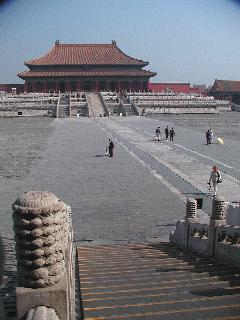
Meridian Line
The meridian line runs due north exactly through the middle of the Forbidden City. On these grounds, with stones 600 years old, soldiers, scholars, and civil servants -- each placed according to station -- heard the orders of the emperor.
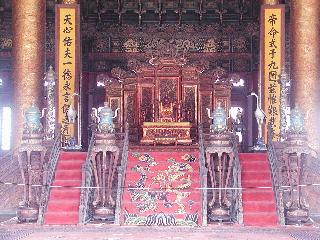
Emperor's Throne
Just one of many thrones for the emperor, this one (like all of them) lies exactly upon the Meridian Line.
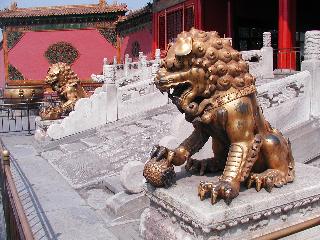
Golden Lions
Two more lions, gilded, protect the gate into the inner courtyard. The damage to the gilding came resulted from invading soldiers looting the precious metal.
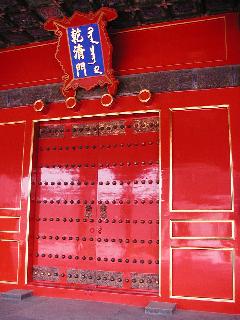
Qian Qing Men
The "Gate of Heavenly Purity" separated the inner courtyard from the ceremonial outer grounds.
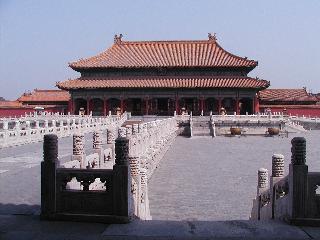
Inner Court
Here senior officials held court and received audience with the Emperor, conducting higher matters of state.
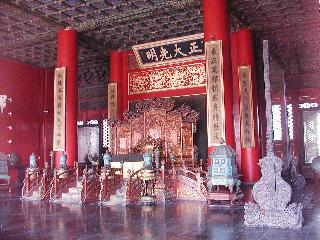
Emperor's Throne
Yet another splendid throne, also along the Meridian Line, and spectacularly crafted.
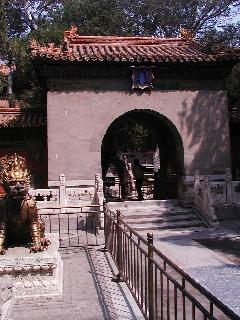
Retreat
In the far northern part of the Forbidden City, the emperor could retreat to the peace and seclusion of private gardens.
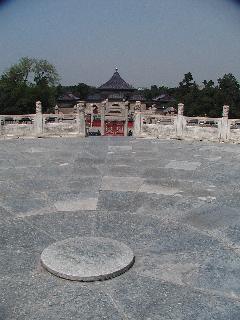
Center of the Universe
Later we visited the Temple of Heaven. If all things earthly are square, according to Chinese aesthetics, heavenly things are round, and such is this three-tier mound. In the foreground can be seen the symbolic center of the universe, where the emperor would offer prayer to heaven. Surrounding the single stone are nine others (nine having great significance.) Each successive ring has 18, 27, and so on stones.
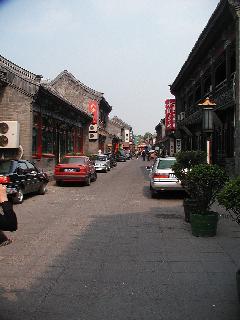
Culture Road
A scheduled trip to a cloisonné factory had to be cancelled due to the SARS scare, but we made up for it with a trip to this little alley of shops filled with all manner of antiques. No strip mall or shopping complex will offer anything to compare to the little treasures you'll find here, where half the experience is haggling over price.
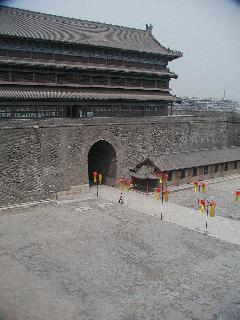
North Gate
As in Beijing, the architecture here has all things earthly in rectangular form. The ancient city of Xi'an was surrounded by a huge wall, a neat rectangular structure nine miles in circumference, and pierced by four gates, each in one of the cardinal directions. Here we see the North gate, through which we came. The ceremonial standards in the assembly grounds of the rampart show the emperor's color of golden yellow.
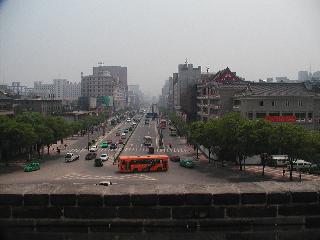
Inward Look
From the high wall we can look into the heart of ancient Xi'an (that is to say, the part within the walls) though as you can see, much of it is quite a bit more recent. In the distance, you might be able to make out the bell tower, kept at the center of the fortified city. It was rung in the morning, marking the start of the day. Near it to the west is the drum tower, struck at night to mark the end.
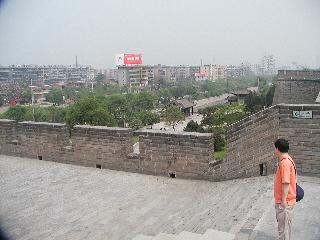
Outward Look
As you can see, Xi'an has grown considerably since the wall was built. It's also surrounded by a moat, now used as a city recreational area. Eddie Law, the local guide for Xi'an seen here, indicates that the wall is the largest intact wall in China.
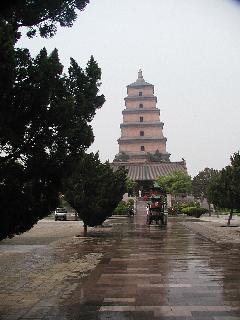
Wild Goose Pagoda
South of the inner city is this pagoda, modeled after one found in India. It was built to contain the original Buddhist scrolls, and the temple surrounding it is still in active use.
Xi'an is on the edge of the desert, and as such is quite dusty; to keep the dust under control, streets (and in this case, the grounds of the temple) are sprayed periodically to keep things under control... for a while.
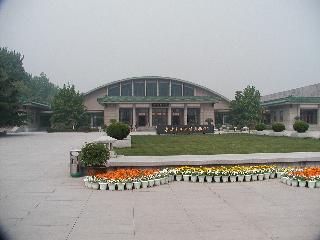
Terra Cotta Warriors Museum
A museum was erected around the excavation. The farmer's land was taken by the state and declared a national treasure. To compensate the man, now considered a hero of the people, he now has the comparatively comfortable job of greeting visitors to the museum.
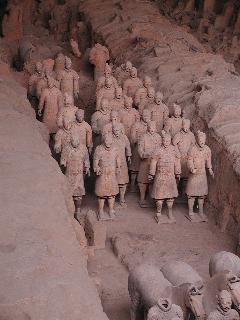
In Formation
The army was arranged in period formations, bore actual arms (though those were lost when the place was burned) and had a support retinue: horses, livestock, and more. Everything the spirit army would need in the afterlife.
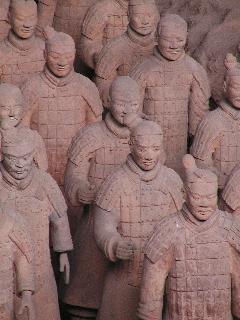
Up Close
Infantrymen, shown here, were made in three pieces. Solid legs, hollow torsos with arms, and individualized heads. Details like arming points and laces are seen on the armor. Faces showed rank (by hair style) and ethnic origins can even be made out.
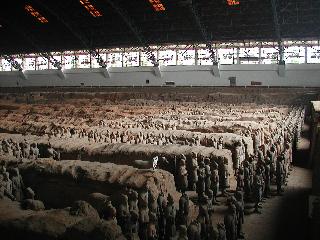
Ready for Orders
Of the eight thousand or so soldiers, only about two thousand have been unearthed. Many were damaged during the uprising, and had to be reconstructed prior to display. More are still being dug out and pieced together, but even at one quarter its original strength, the army is an impressive sight to behold.
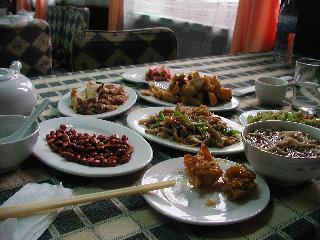
Lunchtime
On the way back from Terra Cotta army, we stopped in for some lunch at a great little place known for their noodles. There was to be a noodle-pulling demonstration, but as with many things in this time of SARS, it had to be cancelled. So we made do with this delicious assortment of zhongguo cai, including roast chicken, mushrooms, celery and chicken, and an intriguing twist on sweet potatoes: potatoes drizzled with caramelized sugar.
A word on Chinese hospitality: just enough food isn't enough, it's seen as being stingy, so most of the time there's more than anyone can possibly eat. Put aside your depression-era reluctance to waste food...
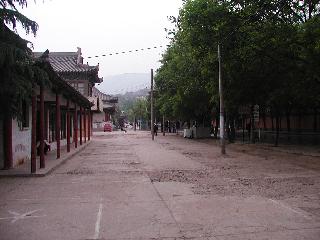
Typical Street
This isn't too atypical a street near Xi'an. Buildings range from the traditionally-roofed as seen here, to modern steel and glass towers, and all periods of buildings in between--usually all intermingled within a few blocks of each other.
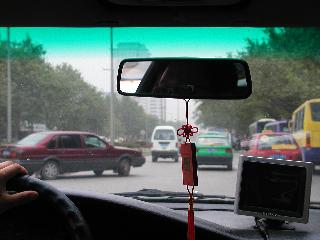
Street Smarts
Don't even think about bringing your drivers license. Aside from the fact that it's not recognized as valid, it wouldn't do you a bit of good. The rules of engagement are entirely different from North America and most of Europe, and unless you've trained here, you'll be out of your element. Leave the driving here to the professionals.
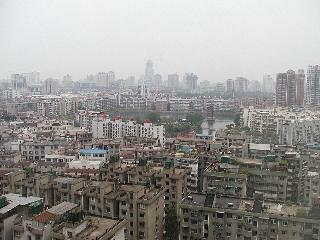
View from the 17th floor
Wuhan is actually three cities that gradually coalesced, divided now only by two rivers that flow past. As with many other parts of China, you see the old and the new, (and everything in between,) intermingled. The Modernizations are ever ongoing.
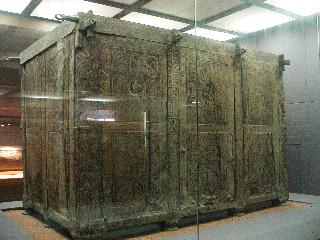
Coffin
Here's the outer coffin that contained the remains of Zeng Hou Yi. This monstrous thing weighs several tons, and is actually the larger of two coffins.
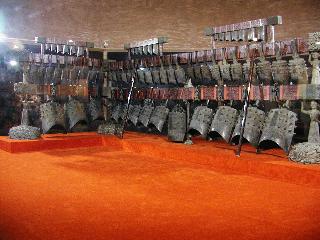
Heavenly Music
The great find in this tomb is this enormous rack of bells. It seems that Zeng Hou Yi liked music very much, and wanted to hear it in the afterlife. This complete instrument, as well as several others, and the coffins of numerous young women (presumably the musicians) were found in the tomb's antechambers.
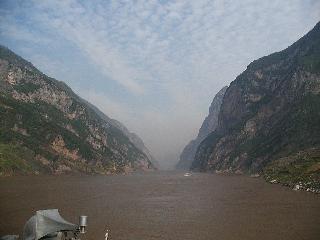
Entering the Gorges
A beautiful day, and impressive scenery, though a little difficult to see through the haze.
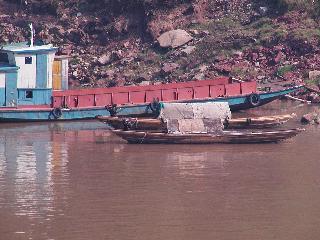
Industry on the Water
Sampan, sometimes motorized, sometimes not, are almost everywhere. An assortment of other sized vessels also struggle against the river's current, or are tethered to the shore.
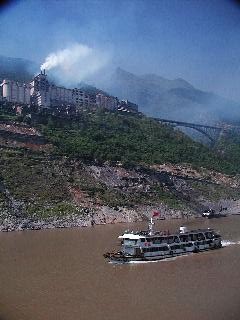
p4304686.jpg
A factory, clearly above the 175 Meter level, is situated far away from the river's edge now, but will be right along the shore in several years. For now, trucks move goods up and down along temporary roads, or roads not yet completely dismantled.
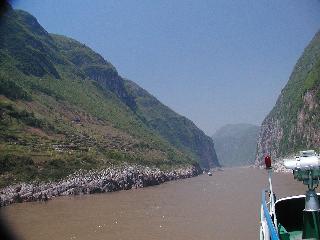
Getting Narrow
This part of the gorge gets pretty narrow (though before the first dam it was even narrower!) After the water rises, the channel will obviously widen.
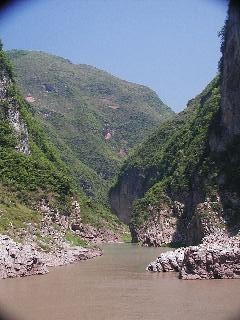
Soon to be Lost
Many smaller gorges such as this will soon be hundreds of feet under water.
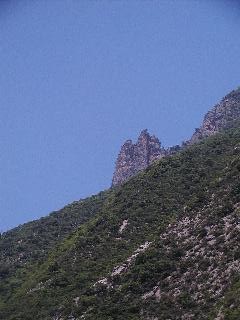
Make a Wish
One sight, happily high above the high-water mark, is Goddess Peak. It's said that after gazing upon the feature, you may make a wish. (It's not clear if that comes with any promises, though!)
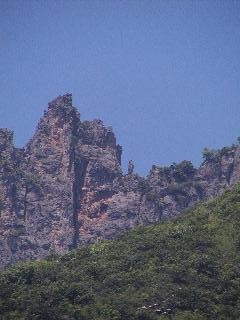
The Goddess Herself
The mystical character that appears in much local lore, the goddess is said to have turned into stone so that she can continue to look out over the river. She's the slender pinnacle in the middle of the picture.
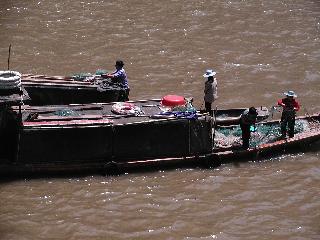
Today's Catch
Fishermen haul in their nets.
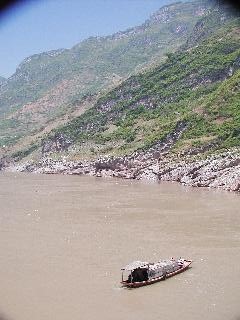
Sampan
A fisherman scurries out of the way of the approaching cruiser.
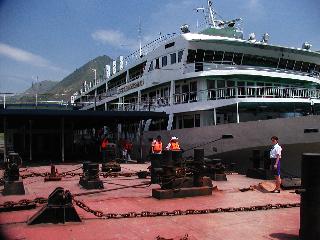
Afternoon in Wushan
We arrived in Wushan for a side excursion up the Lesser Three Gorges in a powerful ferry that none the less had to struggle to make its way up the tiny, nearly pristine tributary.
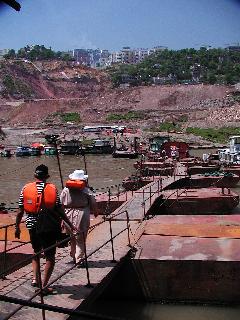
p4304770.jpg
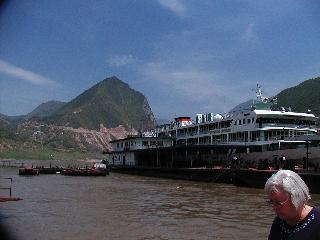
Looking Back
The President 4, moored in quiet waters beneath Wushan is framed beautifully by the gorges through which we had just come.
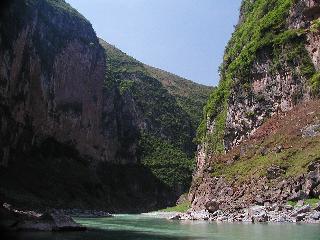
p4304775.jpg
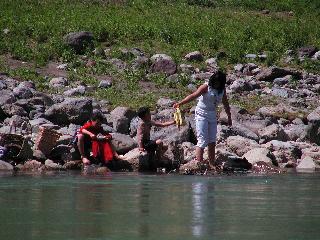
Laundry Day
We can understand if these three young women were too busy to wave back at a bunch of sunburned tourists.
.jpg)
p4304784 (enh).jpg
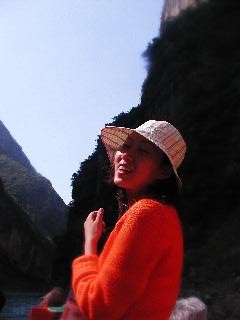
Enjoying Life
Our local guide, Zhao Ling, clearly enjoys her work. She did an excellent job telling the local lore and showing points of interest up the little tributary.
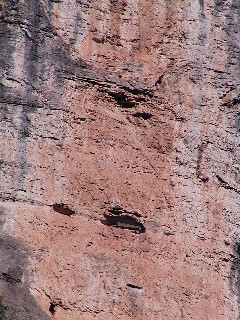
Hanging Coffin
Yesterday on the main river, we saw the place where a hanging coffin used to be kept, but it really wasn't too visible. Here, as we rounded one corner, a huge rock face high above us revealed an actual coffin in situ. Tomorrow we would see a Hanging Coffin exhibit.
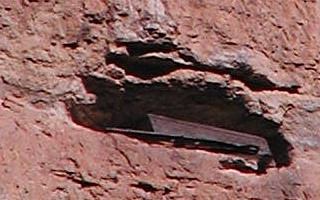
Coffin Close-up
This is just a close-up of the Hanging Coffin above.
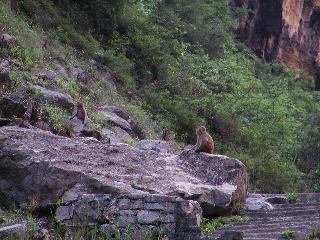
Monkeys Ho!
We got very lucky today that we saw the monkeys; often times they're not so cooperative to be sitting out like that.
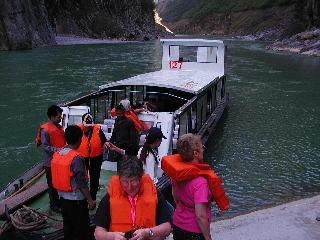
Landing Party
Monkeys sighted, we put ashore at a small pier where the monkeys were seen. Add to that a perfect vantage looking up to a hanging coffin, and I'd have to say we had a good trip.
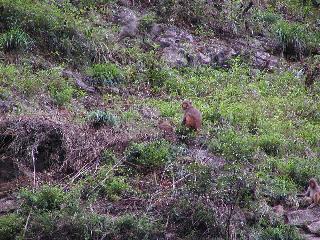
Driven Back
A little uneasy at the brightly-vested tourists, the monkeys retreat up the hillside until we leave.
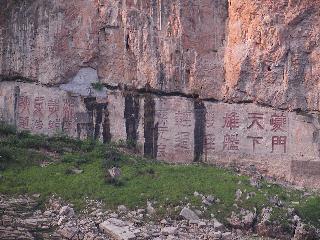
Old Writing
Some Chinese characters cut into the stone near the up-stream end of the gorge will soon be lost beneath the rising waters, though a duplicate inscription appears a few hundred meters downstream. This photograph may easily be the last record of this original carving, as the water is scheduled to rise a meter a day once the next phase of the dam is completed in June 2003.
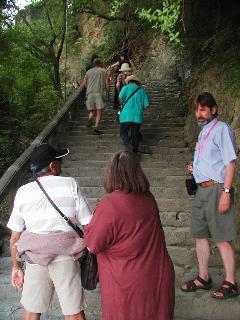
Still Underwater
If you look at the next picture, you'll see we've climbed about 600 of the total 700 steps to the gates of the White Emperor's City, but after 2009, this, too will be under water and the hilltop will become an island.
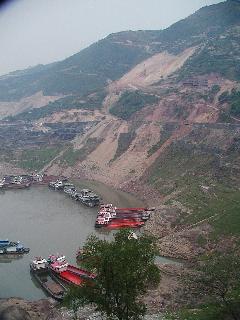
600 Steps Down
The valley below used to be a village, but only the rubble remains. The new town is on the ridge to the right of this photo.
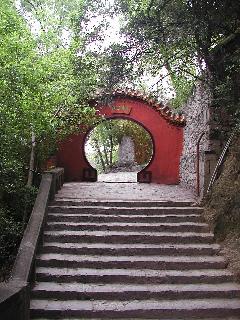
Bamboo Garden Gate
A serene gate welcomes visitors into the bamboo garden after they've ascended the 700 steps from the river's edge.
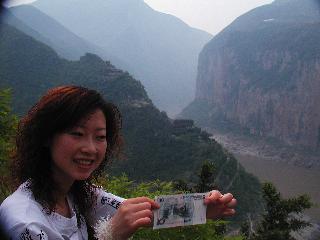
Qutang Panorama
Our local guide holds up the back of a 10-yuan bill, indicating that this gorge is depicted upon it. While the engraving is from a slightly different point, it's clearly recognizable.
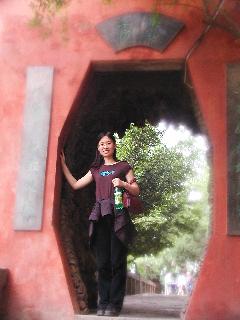
National Treasure
Lulu, a national guide, stops for a moment to pose in one of the many splendid gates on this hilltop. (Normally, she'd be herding us straggling photographers to make sure we didn't fall too far behind!)
The guests on the cruise are unanimous in designating her a national treasure.
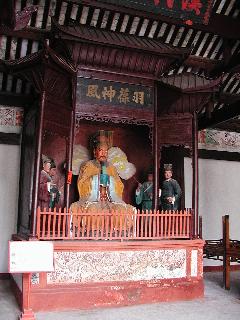
The White Emperor
Named so because steam from a well atop this hill suggested the shape of a white dragon (an imperial symbol) the regional king assumed the name the White Emperor. This statue commemorates him, though it had to be reconstructed; the effigy was beheaded during the Cultural Revolution.
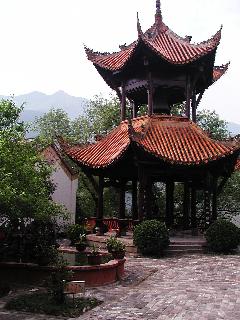
Bell Pavilion
This structure at the edge of a serene garden offers an exquisite view of the river -- soon to be lake -- below.
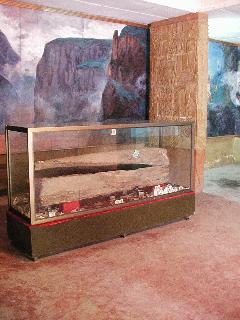
Hanging Coffin
An actual hanging coffin, like the Hanging Coffin in situ yesterday, is shown here under glass. Chinese tourists believe that putting money in the coffin (as seen here) will result in more money in return in the future.
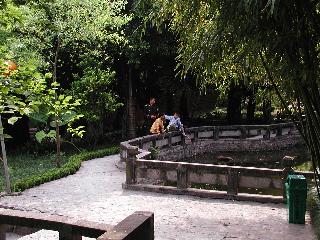
Fishing
Two boys fish in the pond in serene bamboo garden. A police officer looks on.
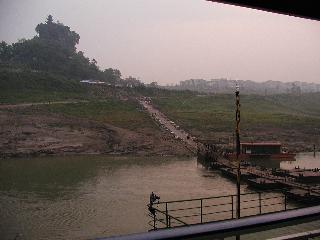
Dawn over Shibaozhai
The hill upon which the temple is built is seen from the presidential suite aboard the President 4. In the distance (to the right of the picture) is the new town; its old counterpart has recently been razed, and only a few merchants' tents remain.
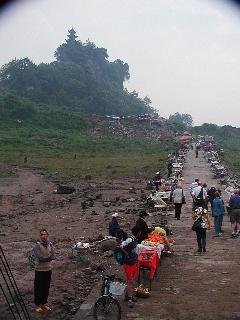
Running the Gauntlet
The only useful remains of the old town is this patchwork path along which various merchants -- some displaced farmers trying their luck selling wares -- vie for tourists' yuan.
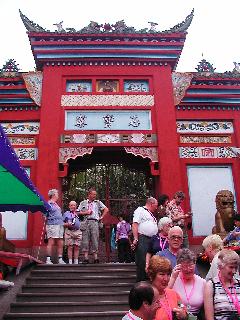
At the Gate
We've created quite a stir for these booth keepers; we're one of the last ships through the area. No more tourist vessels will ply the waters until -- possibly -- September. By then, the water will have risen several dozen meters.
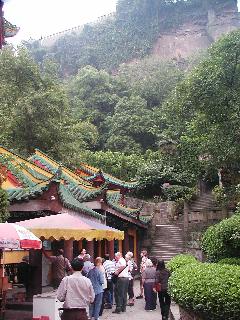
Below 175 Meters
This view from just inside the gates is several meters below the 175-meter mark, but it seems that it won't be under water. I'm told that a barrier wall will be built just outside, and visiting boats will dock, allowing tourists to descend steps to reach the front gate and the grounds.
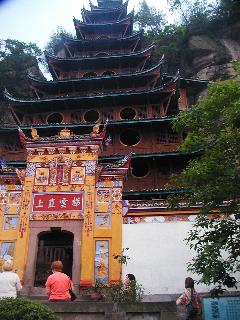
At the Foot of the Pagoda
Pilgrims to this temple used to have to climb up the sheer face of this cliff with little more than a chain to help them. A local carpenter commissioned the wooden pagoda to be built to assist them in their ascent. It consists of nine levels to reach the top ("heaven",) plus two more levels to reach "super heaven."
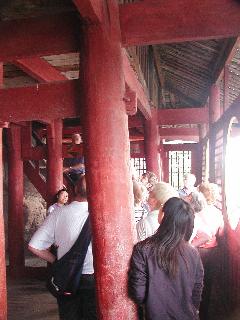
Not a Nail to be Found
The original pagoda was built entirely by using wood joinery; no nails of any sort were used. It was designed to lean against the stone, which bears most of the weight and provides much of the structural integrity. Windows on the remaining three sides afford a view of the surrounding countryside.
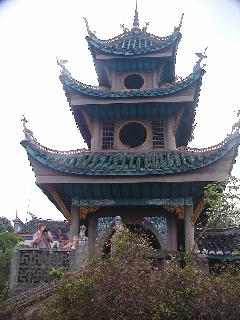
Looking Up from Heaven
From the ninth floor one may go directly to the temple, or further ascend the remaining two floors to super heaven
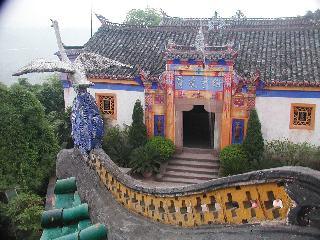
View from "Super Heaven"
This view shows the entrance to the temple compound.
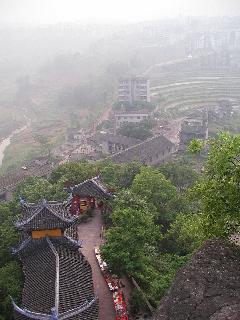
Heaven and Earth
From the north end of the temple, you can look out upon the countryside -- rice paddies and vacant buildings to be demolished. In the distant haze you can make out the new town that replaces them.
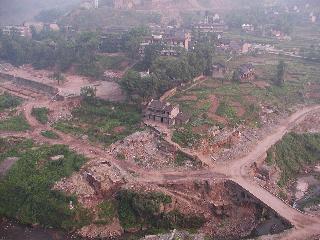
Systematic Destruction
All the old buildings have to be removed (for numerous reasons: navigational hazards, removal of family tombs, recycling resources, etc.) and steady progress is being made. In July, this will be under water.
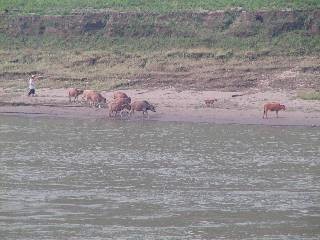
Water buffalo
Once under way again, we see a farmer leading his buffalo to the river's edge; they seem to relish the opportunity and race toward the shore.
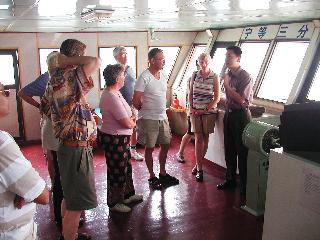
On the Bridge
Our river guide takes us onto the bridge of the President 4.
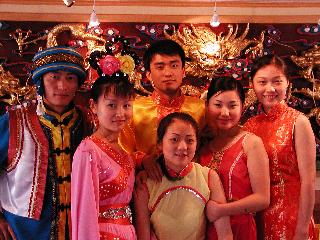
Talented Crew
Not only is the staff of the President 4 extremely courteous and efficient, they're also remarkably talented. Every night they offer us a talent show where, among other things, they demonstrate dances from the various cultural minorities as well as clever sketches and performances.
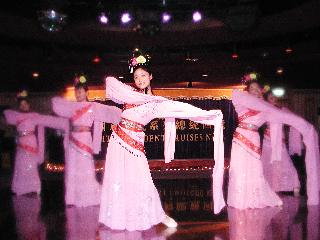
Long-sleeve dance
Five beauties perform the long-sleeve dance; it's hard to believe they just learned this on the ship, but that's what I've been told.
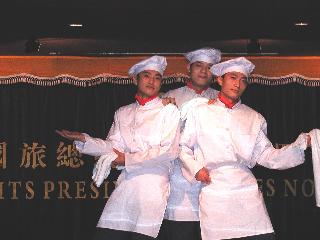
Chef's Dance
The men get in the act, too. Here they do a chef-themed performance; yesterday they did a comical sketch about a master and two servants as good as any vaudeville act.
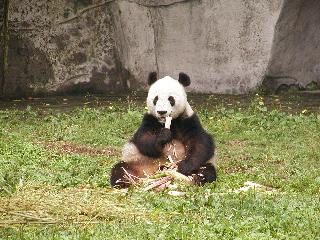
Panda Sighting
Well, in spite of the rush I was able to see a panda or two. Here's one that's munching away on bamboo and sugarcane. Unfortunately, we were in such a rush and the local guide needed to hurry me to the next venue, then lunch, then the airport, so I don't remember this guy's name... Oh well. That's it for Chongqing.
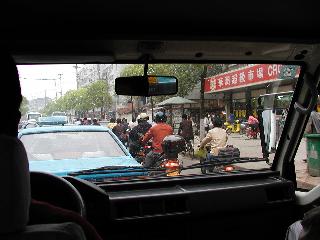
Traffic in Suzhou
After the calm of the Yangtze river, Chongqing and Suzhou's traffic seemed as frenetic as any I've seen
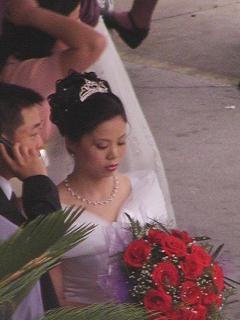
Wedding Day
It seems that the Suzhou hotel is a quite popular wedding spot, and there were two wedding parties situated at the steps of the hotel (two more were still inside!)
Our driver, undaunted by anything smaller than the minibus we were in, simply whipped right up, forcing the crowd to part on his (and my) behalf. Stepping out, I somewhat sheepishly said dui bu qi ("excuse me") with a courtesy nod to the one bride almost immediately in front of me. She in turn gave me the warmest smile -- with that radiant glow reserved only for women on their wedding day. It seems that things like this happen all the time, but my apology was sincerely appreciated.
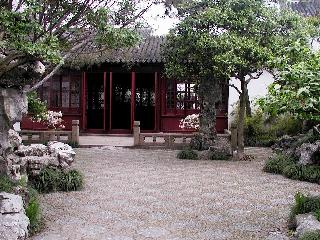
Net Theme
The grounds get their name from the abundant "net" theme that appears throughout the garden, and is most evident in the stonework in this part of the garden. The original owner, a scholar of some note, decided to retire "to the simple life of a fisherman," hence the nets.
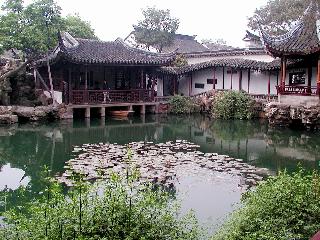
Four Elements
The Chinese garden has four essential elements: Water, stone, plants, and architecture. They are brought into harmony in these sorts of arrangements with subtle symbolism appearing throughout. For example, the water is deliberately green (the color of Jade, for good fortune.) Also, Lotus flowers are described as being the supreme flower, ascending from murk and muck in purity.
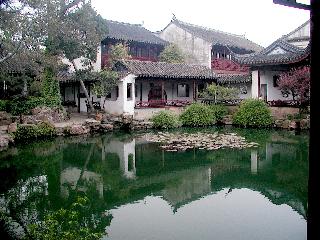
Every Angle a View
There's not supposed to be a bad view inside a masterfully designed garden. Indeed, looking back at at the location from where the previous picture was taken we see this is as pleasing as the first.
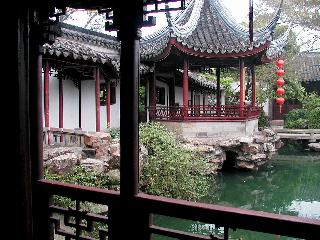
Enjoying the Moon
The pavilion shown here was designed to offer two (and later three) views of the moon: the original, its reflection, and later by a mirror hung on the wall behind it. It must be incredibly beautiful at night.
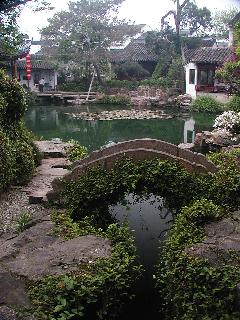
Bridge
Even this "hidden" corner offers a splendid view of the garden.
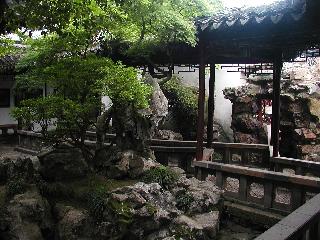
Tai Lake Rock
The unique, fluid character of the rock is deliberate; nearby Tai lake offers these specimens, which are prized in nearly every Chinese garden... some even appear in the Emperor's private gardens in the Forbidden City.
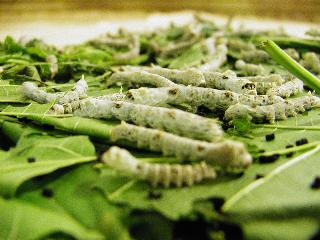
Voracious ten-day-olds
These silkworms are a mere ten days old, and have already grown almost two inches long on their diet of mulberry leaves. In another two weeks they'll become dormant as they spin their prized cocoons.
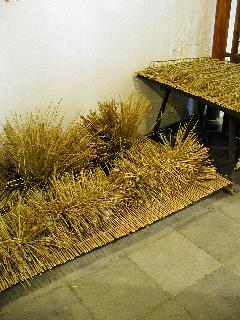
Long Slumber
The worms here have already spun their cocoons, wrapping themselves in as much as a mile of silk fiber. Spring cocoons are said to be the best, offering the longest, strongest fibers, though the harvest occurs year round.
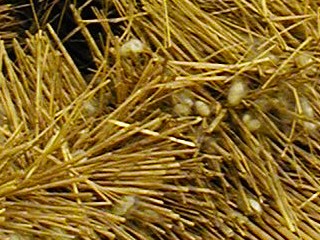
Closeup
Looking a little more closely. Most cocoons contain only a single worm pupa, though some harbor two, (and rarely three) pupae. The silk farmers harvest these bundles, selling them to the silk factories.
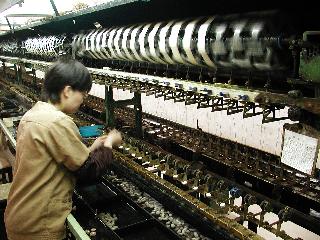
Skilled Hands
The single-worm cocoons are sorted out and are unraveled. Eight slender fibers are then spun to form a single silk thread, the basis for all silk fabric. The attendant replaces exhausted cocoons with new ones to ensure a single, continuous thread that can reach many miles in length.
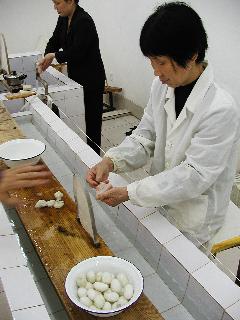
Another Fate for Twins
The double and triple cocoons are too interwoven to be unraveled, so they're destined to become the filling of silk bedding. The cocoons are pulled open, the pupae discarded, and the stringy mat is pulled over the arched bamboo form. When eight cocoons have been pulled thus, they're stretched over a larger form, until a total of eighty cocoons is reached. This is then dried and becomes the raw material for the next step.
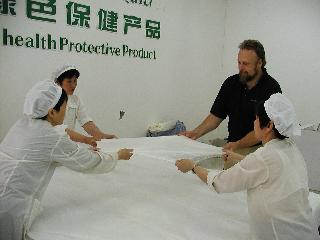
Gossamer Layer
The dried mat is pulled apart to form a single, wispy layer; up to 8,000 cocoons worth of silk are used to form a typical comforter.
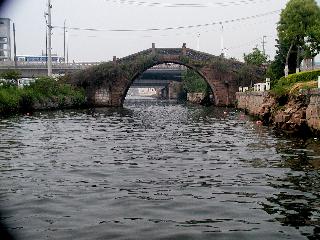
Canals
Gardens, silk, and of course, canals. Here we take a brief excursion onto one of the many canals in Suzhou. The canals are everything here: water source, road, even trash and sewer (though less so nowadays.) Bridges are a common sight throughout the city.
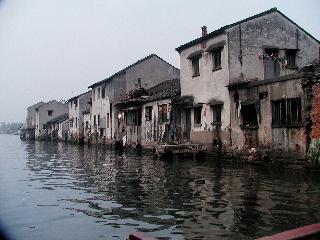
Life on the Water
Windows, even doors, face the canal, and it's an integral part of life here. Farmers carry their goods in and sell from house to house, transferring goods for money through the windows.
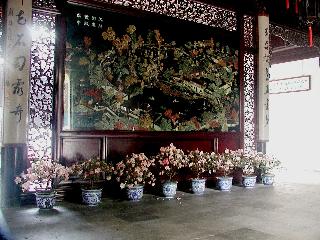
Jade Map
Celebrating a major anniversary, artisans created this jade map of the Lingering Gardens. Exquisitely carved, it illustrates not only the artisans' skill, but also the grounds which we're about to visit.
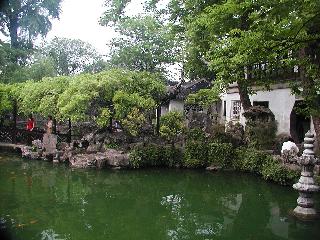
Four Elements in Harmony
Once again, the four elements are brought into harmony in this garden.
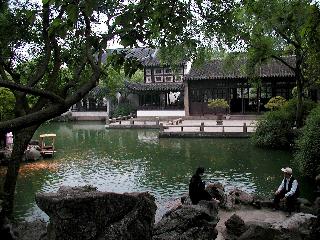
Old Couple and the Fish
An old couple feed the fish; off to the left, a little girl does the same. She seems to be having better luck.
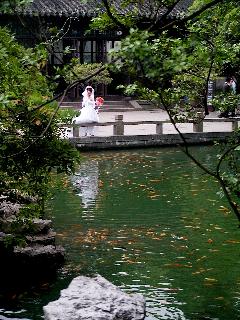
Bridal Spot
Another popular wedding spot in Suzhou, the lingering gardens seems to be a perfect spot -- especially now that very few tourists are lingering here.
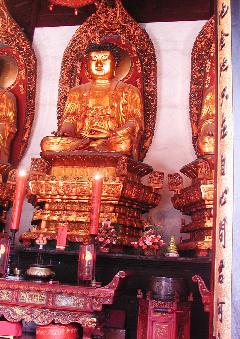
Jade Buddha Temple
The first stop was this working temple. Many pray in front of these gilded statues, but the actual treasures are two jade statues kept locked away.
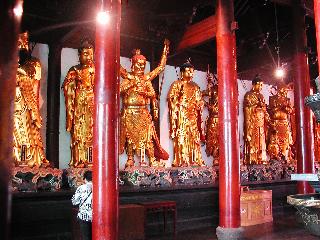
Guardians of Heaven
Along either side of the temple, ten guardians watch out onto the grounds, protecting the temple.
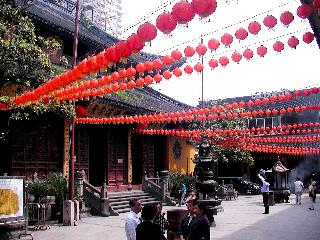
Working Temple
In addition to the devout, one may also see monks and tourists.
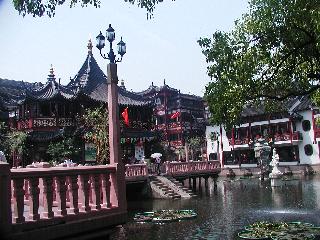
Tea Gardens
A quick hop across town to the old quarter. Here we're in front of a tea house, about to enter the Yu gardens.
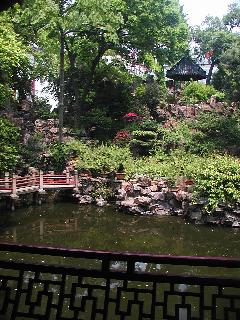
Four Elements
In case you haven't noticed, many bridges in these gardens are crooked, and that's for two reasons: a superstition holds that ghosts can only travel in straight lines, but more practically, the angles force you to change your view...
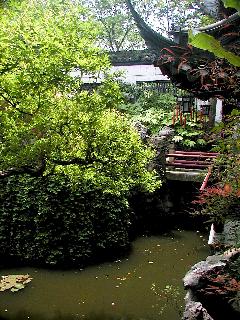
Serenity
There's something very relaxing about these sorts of gardens. Even though a city of 16 million is just stone's throw away, you hardly even notice.
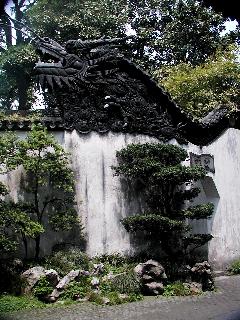
Artful Dragons
This wall is topped by dragons. The original owner built the place because his parents wanted to see the imperial gardens in the Forbidden City, but were too old to make the trip. The dragon is the symbolic representative of the emperor, so in a way, this is the emperor's garden.
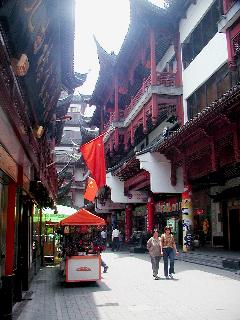
Old Town
This picturesque part of town surrounding the Yu garden is quintessential old China, even though the stores in this thriving business district sell goods from all parts of the world, including sushi and Häagen-Dazs.
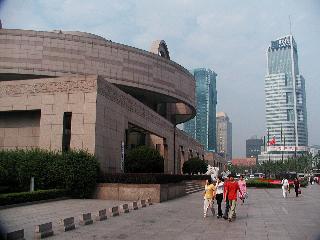
Shanghai Museum
Another stop was the spacious Shanghai Museum. Jade, ancient coins, calligraphy, and all manner of Chinese art are on display here in this bona fide museum.
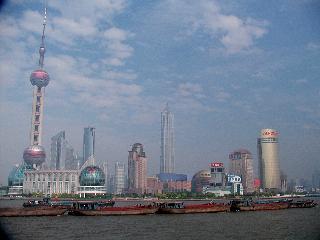
The Bund
China's future. There's quite a bit of history bound up in this part of Shanghai. Behind me are historical buildings from colonial dealings with the west, but in front of me is the gleaming future...

Modernizations
Modernization comes at a price, though. As with almost every other part of China, Shanghai is undergoing radical changes. Out with the old, in with the new is the unspoken credo. Though many old places still stand, gradually the city (and the country) is transforming itself.
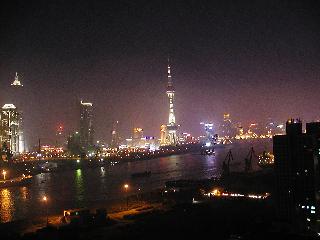
p5065348.jpg
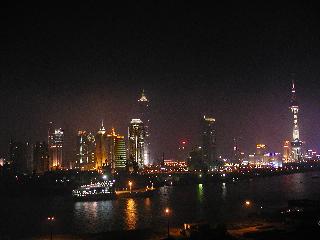
Bund at Night
Capturing this view of the Bund at night, the city is not unlike any other major metropolis in the world. (If only the air conditioning worked....)
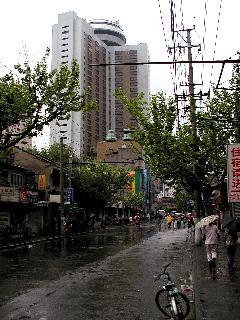
Ocean Hotel
My stroll took me on the street beneath my window -- that's it up there on the 22nd floor, somewhere along the left side. The rain hasn't deterred much in the way of activity, but at this hour most people have already headed off to work. A few school children, locals, and elders mingle along the street.
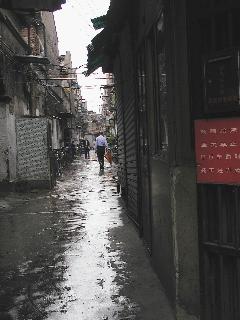
Old Alley
Just a peek down a narrow alley. This is one of the older parts of town; who knows just how much longer things will be this way. The elderly lament the change, the younger crowd look forward to it.
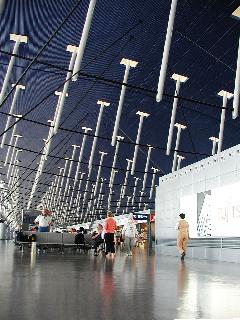
Farewell Shanghai
Sitting at Gate 18, I take this shot of the long tent-like superstructure over Shanghai Pudon airport.
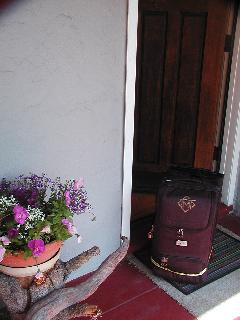
Wo dao le!
Home at last! After two weeks, it's good to be back home... a bit weedier than I remember leaving it, but home none the less.
That was fun.